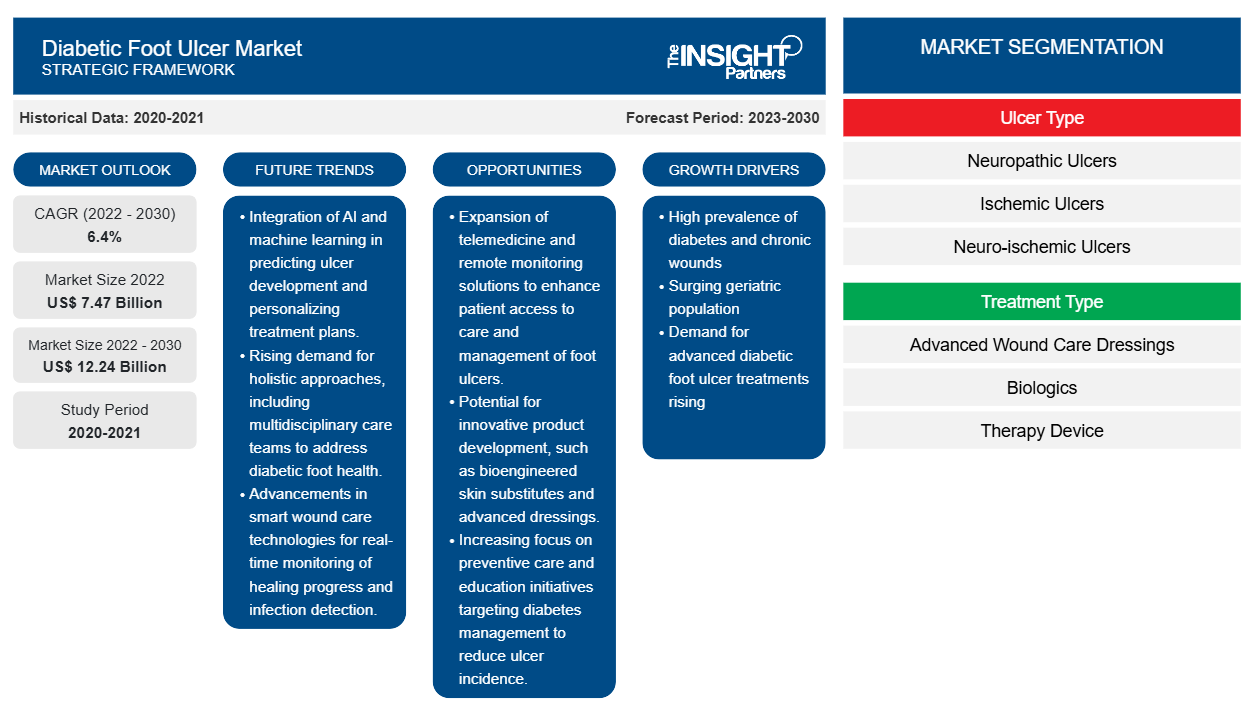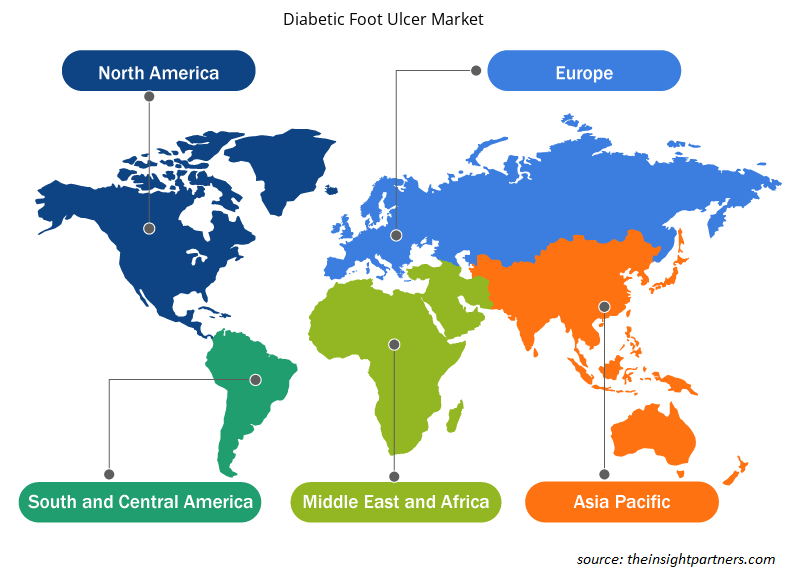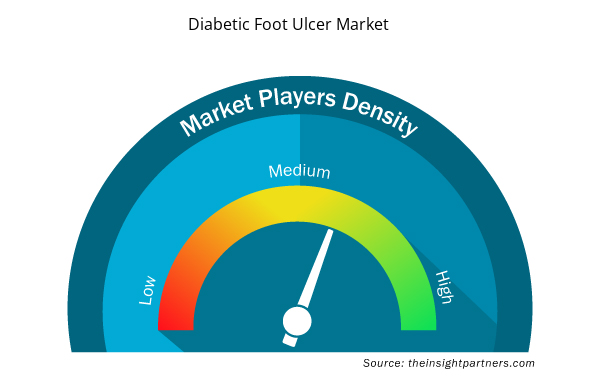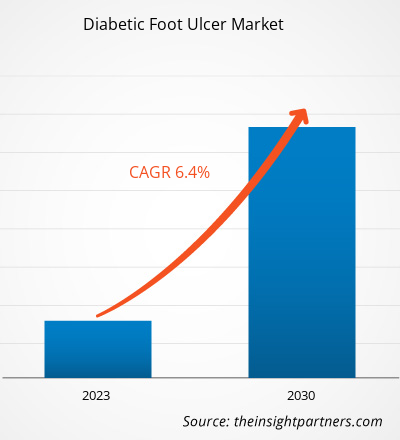[Research Report] The diabetic foot ulcer market size is expected to grow from US$ 7,470.60 million in 2022 and to reach a value of US$ 12,242.77 million by 2030; it is anticipated to record a CAGR of 6.4% from 2022 to 2030.
Market Insights and Analyst View:
Diabetic foot ulcer is a type of chronic wound that often leads to complications and challenges surgeons to manage such injuries. Diabetic foot ulcer leads to full thickness skin loss on the foot due to neuropathic and/or vascular complications in patients with type 1 or type 2 diabetes mellitus. Diabetic patient who uses insulin are at a higher risk of developing a foot ulcer. Key factors driving the diabetic foot ulcer market growth include high prevalence of diabetes and related chronic wounds and surge in geriatric population. However, the high cost of wound management hinders the market growth.
Growth Drivers and Restraints:
Diabetic patients are vulnerable to wounds, and the healing process is usually longer. Depending on healing timeframe, wounds are classified as acute and chronic. Diabetes is a life-threatening chronic disease with no functional cure. Diabetes can lead to various complications in different body parts and increase the overall risk of premature death. According to the International Diabetes Federation (IDF), in 2021, there were ∼537 million adults living with diabetes worldwide. The number is anticipated to increase to 643 million by 2030 and 783 million by 2045. Blood vessels and nerves in the feet of diabetic patients are prone to damages, resulting in numbness. Due to this, diabetic patients have a higher chance of developing diabetic foot ulceration. According to a study published in 2021 in National Center for Biotechnology Information (NCBI), the risk of developing diabetic foot ulcers is between 19% and 34%. A recurrence rate of ~40% is experienced by patients within 1 year of recovery, 60% within 3 years, and 65% within 5 years. As per same study, it is reported that infection develops in 50–60% of ulcers and is the principal cause that damages diabetic feet. Thus, the demand for diabetic foot ulcer treatments is on rise globally, thereby fueling the market growth.
The diabetic foot ulcer market is further driven by surging geriatric population. Age-associated diabetes is common globally. The deficiency of insulin secretion develops with age and the insulin resistance increases due to a change in body composition and sarcopenia. According to Endocrine Society, an estimated 33% of adults aged 65 or older have diabetes. Additionally, the population is more at risk of developing diabetes-related complications. According to the Global Ageing Survey 2019, there will be a notable rise in the number of people aged 65 or above from 1 in 11 in 2019 to 1 in 6 inhabitants by 2025. As per the US Census Bureau, the number of Americans aged 65 and above is anticipated to double from 46 million in 2016 to more than 98 million by 2060, and the share of the elderly population in the global population will increase from 15% to ~24% in the same period. Moreover, the pace of aging (i.e., people aged 60 and above) by 2050 will be nearly a quarter or more in most regions across the world. Older adults are more likely to be diabetic and are further anticipated to develop diabetic foot ulcers and chronic wounds that can severely impact the quality of life. Therefore, with the growing aging population, the demand for advanced diabetic foot ulcer treatments will continue to increase in the coming years.
Customize This Report To Suit Your Requirement
You will get customization on any report - free of charge - including parts of this report, or country-level analysis, Excel Data pack, as well as avail great offers and discounts for start-ups & universities
Diabetic Foot Ulcer Market: Strategic Insights

- Get Top Key Market Trends of this report.This FREE sample will include data analysis, ranging from market trends to estimates and forecasts.
You will get customization on any report - free of charge - including parts of this report, or country-level analysis, Excel Data pack, as well as avail great offers and discounts for start-ups & universities
Diabetic Foot Ulcer Market: Strategic Insights

- Get Top Key Market Trends of this report.This FREE sample will include data analysis, ranging from market trends to estimates and forecasts.
According to Integra LifeSciences Corporation, the cost of diabetic foot ulcers treatment has an enormous burden on the US healthcare system—ranging between US$ 9 and US$ 13 billion annually. According to the data published by the University of Huddersfield, the cost of treating health care associated infections (HCAIs), particularly surgical site infections (SSIs), has been estimated to represent £1 billion (~US$ 1.26 billion) in the UK. Further, according to Diabetes Australia, diabetes-associated limb amputation costs nearly US$ 23,555, with an additional annual expense of US$ 6,065 post surgery. Over five years, diabetes-related amputation amounts to almost US$ 50,000 for the health system, excluding social costs. The area of a wound and the complexity of procedures also determine the cost of the treatment.
The cost of diabetic foot ulcer treatment is also high in Asia Pacific countries such as India, China, and South Korea. According to a study published in 2022 by Elsevier, the cost of diabetic foot ulcer treatment is ~US$ 21,372/patient in China covering amputations, hospitalizations and medical treatments. Similarly, in India, the cost is around ~US$ 19,599/patient including antibiotics, neuropathic drugs, dressings, collagen scaffolds, growth factors, negative pressure wound therapy, and surgery. Thus, the high cost of advanced wound care treatments, despite the availability of reimbursements, is a key factor restraining the diabetic foot ulcer market growth globally.
Report Segmentation and Scope:
The “Global Diabetic Foot Ulcer Market” is segmented on the basis of ulcer type, treatment type, infection severity, and end user. The global diabetic foot ulcer market, by treatment type, is segmented into advanced wound care dressings, biologics, and therapy device. Based on ulcer type, the market is segmented into neuropathic ulcers, ischemic ulcers, neuro-ischemic ulcers. The global diabetic foot ulcer market, by infection severity, is segmented into moderate, mild, and severe. The global diabetic foot ulcer market, by end user, is segmented into ambulatory surgical centers, hospitals, and home care.
The diabetic foot ulcer market, based on geography, is segmented into North America (the US, Canada, and Mexico), Europe (Germany, France, Italy, the UK, Russia, and the Rest of Europe), Asia Pacific (Australia, China, Japan, India, South Korea, and the Rest of Asia Pacific), Middle East & Africa (South Africa, Saudi Arabia, the UAE, and the Rest of Middle East & Africa), and South & Central America (Brazil, Argentina, and the Rest of South & Central America).
Segmental Analysis:
The global diabetic foot ulcer market, by ulcer type, is segmented into neuropathic ulcers, ischemic ulcers, neuro-ischemic ulcers. The neuro-ischemic ulcers segment held the largest market share in 2022 and is anticipated to register the highest CAGR from 2022 to 2030. Neuro-ischemia predominately leads to the development of ulcers on the foot, toes, and dorsum margins, especially on pressure sites occurring among people using poorly fitting shoes. The management of such types of wounds is comparatively complex. The wound requires prompt care, appropriate footwear, offloading, dressings, and infection treatment. Neuro-ischemic ulcers are the most common diabetic foot ulcers (DFUs).
The global diabetic foot ulcer market, by treatment type, is segmented into advanced wound care dressings, biologics, and therapy device. The advanced wound care dressings segment held the largest market share in 2022. The biologics segment is anticipated to register the highest CAGR during 2022–2030. The global diabetic foot ulcer market, by infection severity, is segmented into moderate, mild, and severe. The mild segment held the largest market share in 2022 and is anticipated to register the highest CAGR during the forecast period (2022–2030). The global diabetic foot ulcer market, by end user, is segmented into ambulatory surgical centers, hospitals, and home care. The hospital segment held the largest market share in 2022 and is anticipated to register the highest CAGR from 2022 to 2030.
Regional Analysis:
Based on geography, the global diabetic foot ulcer market is segmented into five key regions: North America, Europe, Asia Pacific, South & Central America, and Middle East & Africa. In 2022, North America held the largest share of the global diabetic foot ulcer market size. Asia Pacific is estimated to register the highest CAGR from 2022 to 2030.
The US diabetic foot ulcers market is primarily driven by the increasing prevalence of diabetes in the country. As per the American Podiatric Medical Association, in the US, nearly 14–24% of patients with diabetes who develop foot ulcers require an amputation. According to the Health Innovation Program, ~2 million people in America develop a diabetic foot ulcer annually. Furthermore, according to a study published in NCBI in 2022, ~5% of patients in the US with diabetes mellitus develop foot ulcers, and 1% end up with an amputation. The growing geriatric population in the region also boosts the market growth. According to the Administration on Aging (US Department of Health and Human Services) report published in 2022, there were 55.7 million people aged 65 and above in 2020 in the US. The old age group represents 17% of the population, i.e., 1 in every 6 Americans. As per estimates by the Urban Institute (Washington, DC-based think tank), the number of people aged 65 and older will double over the next 40 years, reaching 80 million in 2040 in the US. Additionally, In 2020, diabetes is regarded as among the leading chronic conditions among adults aged 65 and above. In recent years, several joint ventures, initiatives, and collaborations contributed in accelerating the diabetic foot ulcers market expansion in North America. For instance, in 2020, six research institutions in the US launched the first-ever multicenter network funded by the National Institutes of Health to study diabetic foot ulcers in the US. Additionally, the Diabetic Foot Canada program was launched in Canada to prevent diabetic foot complications. Thus, the high prevalence of diabetes and the increasing geriatric population will drive the market growth in the region.
Industry Developments and Future Opportunities:
Various initiatives taken by key players operating in the global diabetic foot ulcer market are listed below:
- In January 2023, Convatec announced the launch of ConvaFoam, a family of advanced foam dressings designed to address the needs of healthcare providers and their patients. ConvaFoam can be used on a broad spectrum of wound types at any stage of the wound journey, making it the simple dressing choice for wound management and skin protection.
- In January 2023, MiMedx Group Inc announced that it had entered into an exclusive distribution agreement with GUNZE MEDICAL LIMITED (“Gunze Medical”), a subsidiary of Gunze Limited, for sales of EPIFIX in Japan. Gunze Medical is a leading distributor of products used in a wide range of wound and surgical settings, including bioabsorbable devices and materials, such as sutures and sheet products.
- In March 2022, Convatec entered the attractive wound biologics segment by acquiring Triad Life Sciences Inc. The company develops biologically derived innovative products to address unmet clinical needs in surgical wounds, chronic wounds, and burns.
- In July 2022, Smith+Nephew announced the launch of the WOUND COMPASS Clinical Support App. It is a comprehensive digital support tool for healthcare professionals that aids wound assessment and decision-making to help reduce practice variation. The App helps improve nurse confidence when assessing and treating wounds and reassuring specialist nurses that their formulary is followed.
- In January 2020, Convatec Group Plc announced the launch of ConvaMax, the new superabsorber dressing. It is used to manage highly exuding wounds, including leg ulcers, pressure ulcers, diabetic foot ulcers, and dehisced surgical wounds.
Diabetic Foot Ulcer Market Regional Insights
The regional trends and factors influencing the Diabetic Foot Ulcer Market throughout the forecast period have been thoroughly explained by the analysts at Insight Partners. This section also discusses Diabetic Foot Ulcer Market segments and geography across North America, Europe, Asia Pacific, Middle East and Africa, and South and Central America.

- Get the Regional Specific Data for Diabetic Foot Ulcer Market
Diabetic Foot Ulcer Market Report Scope
| Report Attribute | Details |
|---|---|
| Market size in 2022 | US$ 7.47 Billion |
| Market Size by 2030 | US$ 12.24 Billion |
| Global CAGR (2022 - 2030) | 6.4% |
| Historical Data | 2020-2021 |
| Forecast period | 2023-2030 |
| Segments Covered |
By Ulcer Type
|
| Regions and Countries Covered | North America
|
| Market leaders and key company profiles |
Diabetic Foot Ulcer Market Players Density: Understanding Its Impact on Business Dynamics
The Diabetic Foot Ulcer Market is growing rapidly, driven by increasing end-user demand due to factors such as evolving consumer preferences, technological advancements, and greater awareness of the product's benefits. As demand rises, businesses are expanding their offerings, innovating to meet consumer needs, and capitalizing on emerging trends, which further fuels market growth.
Market players density refers to the distribution of firms or companies operating within a particular market or industry. It indicates how many competitors (market players) are present in a given market space relative to its size or total market value.
Major Companies operating in the Diabetic Foot Ulcer Market are:
- Convatec Group Plc
- 3M Co
- Coloplast AS
- Smith & Nephew Plc
- B. Braun SE
Disclaimer: The companies listed above are not ranked in any particular order.

- Get the Diabetic Foot Ulcer Market top key players overview
Competitive Landscape and Key Companies:
Convatec Group Plc, 3M Co, Coloplast AS, Smith & Nephew Plc, B. Braun SE, Molnlycke Health Care AB, MiMedx Group Inc, URGO MEDICAL Australia Pty Ltd, Medline Industries LP, and Organogenesis Inc are among the prominent players operating in the diabetic foot ulcer market. These companies focus on new technologies, advancements in existing products, and geographic expansions to meet the growing consumer demand worldwide and increase their product range in specialty portfolios.
- Historical Analysis (2 Years), Base Year, Forecast (7 Years) with CAGR
- PEST and SWOT Analysis
- Market Size Value / Volume - Global, Regional, Country
- Industry and Competitive Landscape
- Excel Dataset


- Health Economics and Outcome Research (HEOR) Services Market
- Nurse Call Systems Market
- Non-Emergency Medical Transportation Market
- Photo Editing Software Market
- Dairy Flavors Market
- Sexual Wellness Market
- Artificial Intelligence in Healthcare Diagnosis Market
- Cling Films Market
- Influenza Vaccines Market
- Hot Melt Adhesives Market

Report Coverage
Revenue forecast, Company Analysis, Industry landscape, Growth factors, and Trends

Segment Covered
Ulcer Type, Treatment Type, Infection Severity, End User, and Geography

Regional Scope
North America, Europe, Asia Pacific, Middle East & Africa, South & Central America

Country Scope
This text is related
to country scope.
Frequently Asked Questions
What factors drive the diabetic foot ulcer market?
Factors such as high prevalence of diabetes and related chronic wounds and surge in geriatric population propel market growth.
Who are the major players in the diabetic foot ulcer market?
The diabetic foot ulcer market has major market players, including Convatec Group Plc, 3M Co, Coloplast AS, Smith & Nephew Plc, B. Braun SE, Molnlycke Health Care AB, MiMedx Group Inc, URGO MEDICAL Australia Pty Ltd, Medline Industries LP, and Organogenesis Inc.
What was the estimated diabetic foot ulcer market size in 2022?
The diabetic foot ulcer market was valued at US$ 7,470.60 million in 2022.
What are the growth estimates for the diabetic foot ulcer market till 2030?
The diabetic foot ulcer market is expected to be valued at US$ 12,242.77 million in 2030.
What is diabetic foot ulcer?
Diabetic foot ulcer is a type of chronic wound that often leads to complications and challenges surgeons to manage such injuries. Diabetic foot ulcer leads to full thickness skin loss on the foot due to neuropathic and/or vascular complications in patients with type 1 or type 2 diabetes mellitus. Diabetic patient who uses insulin are at a higher risk of developing a foot ulcer.
Which infection severity segment dominates the diabetic foot ulcer market?
The global diabetic foot ulcer market, by infection severity, is segmented into moderate, mild, and severe. The mild segment held the largest market share in 2022 and the same segment is anticipated to register the highest CAGR from 2022 to 2030.
Which ulcer type segment dominates the diabetic foot ulcer market?
The global diabetic foot ulcer market, by ulcer type, is segmented into neuropathic ulcers, ischemic ulcers, neuro-ischemic ulcers. The neuro-ischemic ulcers segment held the largest market share in 2022 and the same segment is anticipated to register the highest CAGR from 2022 to 2030.
Which end user segment dominates the diabetic foot ulcer market?
The global diabetic foot ulcer market, by end user, is segmented into ambulatory surgical centers, hospitals, and home care. The hospital segment held the largest market share in 2022 and the same segment is anticipated to register the highest CAGR from 2022 to 2030.
Which treatment type segment dominates the diabetic foot ulcer market?
The global diabetic foot ulcer market, by treatment type, is segmented into advanced wound care dressings, biologics, and therapy device. The advanced wound care dressings segment held the largest market share in 2022. The biologics segment is anticipated to register the highest CAGR during 2022–2030.
Trends and growth analysis reports related to Life Sciences : READ MORE..
The List of Companies - Diabetic Foot Ulcer Market
- Convatec Group Plc
- 3M Co
- Coloplast AS
- Smith & Nephew Plc
- B. Braun SE
- Molnlycke Health Care AB
- MiMedx Group Inc
- URGO MEDICAL Australia Pty Ltd
- Medline Industries LP
- Organogenesis Inc.

 Get Free Sample For
Get Free Sample For